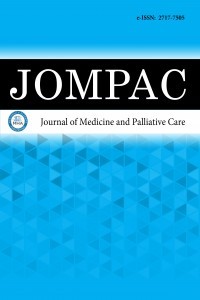Sağlık bakımı ilişkili enfeksiyonlarda Staphylococcus aureus dağılımının irdelenmesi: 6 yıllık deneyim
Staphylococcus aureus, MRSA, yoğun bakım ünitesi, sağlık bakım ilişkili enfeksiyon
Sağlık bakımı ilişkili enfeksiyonlarda Staphylococcus aureus dağılımının irdelenmesi: 6 yıllık deneyim
___
- Tong SY, Davis JS, Eichenberger E, Holland TL, Fowler VG Jr. Staphylococcus aureus infections: epidemiology, pathophysiology, clinical manifestations, and management. Clin Microbiol Rev 2015; 28: 603-61.
- Jevons MP, Coe AW, Parker MT. Methicillin resistance in staphylococci. Lancet 1963; 1: 904-7.
- “Central Asian and Eastern European Surveillance of Antimicrobial Resistance. Annual report 2018”. http://www.euro.who.int/en/health-topics/diseaseprevention/antimicrobialresis tance/publications/2018/central-asian-andeastern-european-surveillance-of-antimicrobialresis tance-annual-report-2018-2018 Erişim tarihi: 12.12.2021.
- Patel M. Community-associated meticillin-resistant Staphylococcus aureus infections. Drugs 2009; 69: 693-716.
- Ulusal Sağlık Hizmeti İlişkili Enfeksiyonlar Sürveyans Rehberi 2017. https://hsgm.saglik.gov.tr/depo/birimler/Bulasici-hastaliklar-db/hastaliklar/SHIE/Klavuzlar/Ulusal_Saglik_Hizmeti_Iliskili_Enfeksiyonlar_Surveyans_Rehberi. Erişim tarihi:13.12.2021.
- European Committee on Antimicrobial Susceptibility Testing Breakpoint tables for interpretation of MICs and zone diameters Version 8.0. EUCAST. (01.01.2018).
- European Committee on Antimicrobial Susceptibility Testing Breakpoint tables for interpretation of MICs and zone diameters Version 9.0. EUCAST. (23.12.2018).
- European Committee on Antimicrobial Susceptibility Testing Breakpoint tables for interpretation of MICs and zone diameters Version 10.0. EUCAST. (01.01.2020).
- European Centre for Disease Prevention and Control, Antimicrobial resistance surveillance in Europe 2015. Annual Report of the European Antimicrobial Resistance Surveillance Network (EARS-Net). Stockholm: ECDC; (2017).
- European Centre for Disease Prevention and Control. Surveillance of antimicrobial resistance in Europe 2018. Stockholm: EDCC; 2019.
- European Centre for Disease Prevention and Control. Antimicrobial resistance in the EU/EEA (EARS-Net)- Annual Epidemiological Report 2019. Stockholm: ECDC; 2020.
- Gurung RR, Maharjan P, Chhetri GG. Antibiotic resistance pattern of Staphylococcus aureus with reference to MRSA isolates from pediatric patients. Future Sci OA 2020; 6: 464-75.
- Wandre AS, Agrawal GN. Antibiogram of clinical isolates of Staphylococcus aureus from a tertiary care centre, Int J Res Rev 2020; 7: 307-10.
- Zenci M, Arı A, Yılmaz N, et al. Metisiline dirençli Staphylococcus aureus suşlarının antibiyotiklere duyarlılığı, hastaların klinik özellikleri ve mortaliteyi etkileyen faktörler. ANKEM Derg 2016; 30: 18-23.
- Yüksekkaya Ş, Opuş A, Güvenç Hİ, et al. 2009-2013 Yılları arasında Konya Eğitim ve Araştırma Hastanesi’nde kan kültüründen izole edilen Staphylococcus aureus suşlarının antimikrobiyal ajanlara duyarlılıklarının değerlendirilmesi. ANKEM Derg 2017; 31: 1-6.
- Özkaya E, Tümer S, Kirişci Ö, Çalışkan A, Erdoğmuş P. Son iki yılda Kahramanmaraş Necip Fazıl Şehir Hastanesi’nde kan kültürlerinden izole edilen mikroorganizmalar ve antibiyotik duyarlılıklarının değerlendirilmesi. Turk Hij Den Biyol Derg 2015; 72: 115-22.
- Çelik C, Bakıcı MZ, Gözel MG, EnginA, Kaya H. Kan akımı enfeksiyonlarından izole edilen Staphylococcus aureus suşlarında antimikrobiyal direnç paterni. Genel Tıp Derg 2013; 23: 109-13.
- Ippolito G, Leone S, Lauria FN, Nicastri E, Wenzel RP. Methicillin-resistant Staphylococcus aureus: the superbug, Int J Infect Dis 2010; 14: 7-11.
- Cosgrove SE, Qi Y, Kaye KS, Harbarth S, Karchmer AW, Carmeli Y. The impact of methicillin resistance in Staphylococcus aureus bacteremia on patient outcomes: mortality, length of stay, and hospital charges. Infect Control Hosp Epidemiol 2005; 26: 166-74.
- Bonnal C, Birgand G, Lolom I, et al. Staphylococcus aureus healthcare associated bacteraemia: An indicator of catheter related infections. Med Mal Infect. 2015; 45: 84-8.
- Tekerekoğlu MS, Duman Y, Serindağ A, et al. Do mobile phones of patients,companions and visitors carrymultidrug-resistant hospital pathogens? AJIC 2011; 39: 379-81.
- Genc O, Arikan I. The relationship between hand hygiene practices and nasal Staphylococcus aureus carriage in healthcare workers. Med Lav. 2020; 24: 54-62.
- Başlangıç: 2020
- Yayıncı: MediHealth Academy Yayıncılık
Gülay ÜLGER, Musa ZENGİN, Funda İNCEKARA, Ramazan BALDEMİR, Hilal SAZAK, Ali ALAGÖZ
Esra KAYA KILIÇ, Şerife Altun DEMİRCAN, Sami KINIKLI, Salih CESUR, Ayşe BÜYÜKDEMİRCİ, Cigdem ATAMAN HATİPOGLU, Şebnem ERDİNÇ, Gunay TUNCER ERTEM, Mihriban YÜCEL
Kolorektal kanserlerin yeniden evrelemesinde F-18 FDG PET/BT’nin önemi
Alev ÇINAR, Esra Arzu GENCOGLU
Tiroid bezi neoplazmalarının etiyolojik faktörlerinin değerlendirilmesi: klinik deneyimimiz
Salih CELEPLİ, İrem BİGAT, Baki TÜRKOĞLU, Pınar CELEPLİ, Mujdat TURAN
Görme kaybı ve serebral apse ile seyreden geç tanı konan bir rinoorbitoserebral mukormikozis olgusu
Salih CESUR, Melek Sena ALTUN, Cigdem ATAMAN HATİPOGLU, Şerife Altun DEMİRCAN, Selin ŞENOL, Ülkü SİYAH, Sami KINIKLI, Hafize Nalan GÜNEŞ, Tahir YOLDAŞ
COVID-19 tanısında göğüs tomografisinin rolü
Mesut DEMİRKÖSE, Tülay ÜNVER ULUSOY, Semiha Solak GRASSİE, Dilek YAPAR, Hacer DEMİRKÖSE, Mustafa Emre AKIN, Semih AYDEMİR, Mehmet Raşit AYTE, Hilal SAZAK, Ali ALAGÖZ
COVID-19 pnömonisinde erken ve geç dönemde favipiravir: retrospektif gözlemsel bir çalışma
Ayşe AYYILDIZ, Nurdan ÇOBANER, Nurettin ERBEN, Birgül YELKEN
Port kateter bakımına ilişkin hemşirelik uygulamalarının belirlenmesi
Muharrem ÖZTAŞ, İpek ALKAN, Bediye ÖZTAŞ
Manual lenfatik drenajın total diz artroplastisini takip eden toparlanma süreci üzerindeki etkisi
Özge VERGİLİ, İbrahim Deniz CANBEYLİ, Barış Kemal ÖZSAR, Birhan OKTAŞ, Savaş KESKİN
